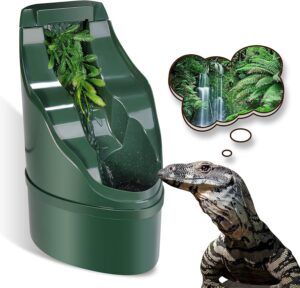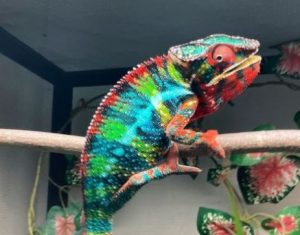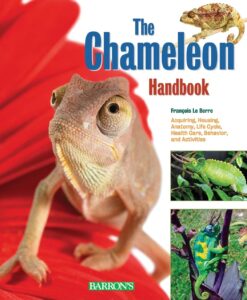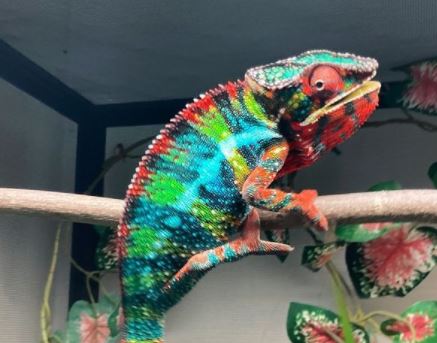How big do veiled chameleons get
How big do veiled chameleons get: Veiled chameleons (Chamaeleo calyptratus) have become increasingly popular as reptile pets in recent years. These fascinating creatures are native to the mountainous regions of Yemen and Saudi Arabia, where they inhabit a wide range of environments from dense tropical forests to arid scrublands. Their popularity as pets can be attributed to their striking appearance, unique behavior, and captivating ability to change colors.
As reptiles belonging to the Chamaeleonidae family, veiled chameleons possess several remarkable physical features that set them apart from other species. One of their most distinctive traits is their prehensile tail, which acts as an essential tool for balance while climbing and helps them maintain stability when perched on branches or other surfaces.
 Additionally, they possess highly dexterous feet with fused toes that enable them to grip onto various substrates with exceptional agility. However, what truly captivates enthusiasts about veiled chameleons is their mesmerizing color-changing ability.
Additionally, they possess highly dexterous feet with fused toes that enable them to grip onto various substrates with exceptional agility. However, what truly captivates enthusiasts about veiled chameleons is their mesmerizing color-changing ability.
These reptiles are renowned for their remarkable camouflage skills, allowing them to blend seamlessly with their surroundings and evade potential predators or silently approach prey. Their skin pigment cells called chromatophores are responsible for this incredible phenomena; these cells contain pigments that expand or contract based on different environmental factors such as light intensity, temperature variations, or emotional changes.
Furthermore, veiled chameleons exhibit striking sexual dimorphism – meaning there are noticeable differences between males and females in terms of size and coloration. Male chameleons often showcase vibrant hues such as bright greens and blues along with intricate patterns on their bodies during courtship displays or when expressing aggression towards rival males.
On the other hand, female chameleons tend to display more subdued colors like olive green or brown. Veiled chameleons have gained immense popularity among reptile enthusiasts due to their unique physical attributes and captivating ability to change colors.
Their prehensile tail, dexterous feet, and exceptional camouflage skills make them fascinating creatures to observe and interact with. Additionally, the pronounced sexual dimorphism adds an extra layer of intrigue, making veiled chameleons an aesthetically appealing choice for reptile enthusiasts of all levels.
General Size Range of Veiled Chameleons
Veiled chameleons (Chamaeleo calyptratus) are renowned for their charismatic appearance and unique ability to change colors. As one of the most popular reptile pets, these fascinating creatures captivate enthusiasts with their distinctive physical features. Understanding the typical size range of adult veiled chameleons is essential for providing optimal care and ensuring their well-being.
Males: On average, male veiled chameleons tend to be larger than their female counterparts. These vibrant creatures can measure around 17-24 inches (43-61 cm) in length from snout to tail tip.
Their body structure is robust, characterized by a prominent casque on top of their heads, enlarged tarsal spurs on the hind legs, and a long prehensile tail that aids in climbing and maintaining balance. Females: Generally smaller than males, female veiled chameleons measure about 12-14 inches (30-36 cm) in length.
While they lack some of the exaggerated physical attributes seen in males, females still possess remarkable characteristics. They exhibit a more streamlined body shape and have smaller casques compared to their male counterparts.
Additionally, female veiled chameleons have shorter tails that serve as an aid for climbing and grasping branches. The size range mentioned above provides a general guideline; however, it is important to note that individual variations exist within each gender.
Factors such as genetics and environmental conditions can influence the ultimate size potential of veiled chameleons. By understanding these size differences between males and females, reptile enthusiasts can better tailor their care practices to support healthy growth and overall well-being.
Genetics and Lineage
When it comes to the size potential of veiled chameleons, genetics and lineage play a significant role. Like many other living organisms, the genes inherited from their parents influence the growth patterns and overall size of individual chameleons.
Some bloodlines are known for producing larger specimens, while others tend to yield smaller ones. Moreover, selective breeding programs have further contributed to the size variations within veiled chameleons.
Breeders have focused on producing larger or smaller individuals by carefully selecting parent chameleons with desirable size traits. Over time, this deliberate manipulation has led to observable differences in size among different lineages of veiled chameleons.
Breeding Programs
Breeding programs targeting specific size characteristics have resulted in intriguing variations within the veiled chameleon species. By selectively pairing larger individuals over several generations, breeders have been able to develop bloodlines that consistently produce larger adult chameleons.
On the other hand, breeders aiming for smaller sizes pair individuals with naturally smaller frames or selectively breed down from larger parents. However, it is essential to note that while these breeding efforts have influenced size variations within captive-bred veiled chameleons, wild populations may exhibit different average sizes due to factors such as natural selection and environmental conditions.
Environmental Factors Affecting Growth and Development
Adequate Nutrition
A proper diet rich in calcium, vitamins, and minerals is crucial for healthy growth in veiled chameleons. These reptiles require a varied diet consisting mainly of live insects such as crickets or roaches dusted with nutritional supplements. Calcium plays a vital role in bone development and muscle function while vitamins contribute to overall health and immunity.
Malnutrition, particularly calcium deficiency, can lead to stunted growth and skeletal deformities in veiled chameleons. Therefore, it is crucial for chameleon owners to provide a well-rounded diet supplemented with calcium and other essential nutrients to ensure optimal growth and development.
Temperature Regulation
Maintaining appropriate temperature gradients within the chameleon’s enclosure is crucial for optimizing metabolism and promoting healthy growth. Veiled chameleons are ectothermic creatures, meaning their body temperature is influenced by their environment.
They require a thermal gradient that allows them to thermoregulate effectively. The basking spot should be maintained at around 90-95°F (32-35°C), while cooler areas of the enclosure should range between 70-80°F (21-27°C).
This temperature variation allows chameleons to adjust their body temperature as needed for digestion, metabolism, and overall growth. Inadequate temperature regulation can hinder metabolism and slow down growth rates in veiled chameleons.

Enclosure Size
Sufficient space within the chameleon’s enclosure is vital for promoting muscle development and overall physical health. Veiled chameleons are arboreal reptiles that spend a significant amount of time climbing, perching, and exploring their surroundings. A spacious enclosure with ample vertical height allows them to engage in natural behaviors like climbing branches or foliage.
A cramped environment restricts their movement and may result in underdeveloped muscles or even stress-related health issues. To support optimal size potential, providing an adequately sized enclosure with various climbing structures not only promotes muscle development but also contributes to mental stimulation and overall well-being.
Growth Stages and Age Milestones in Veiled Chameleons
Hatchlings: A Burst of Life in a Tiny Package
Veiled chameleon hatchlings emerge into the world measuring a mere two inches (5 cm) in length. At this miniature size, they possess all the characteristic features of their adult counterparts, including the iconic casque on their heads and long, grasping tails. These tiny marvels exhibit an extraordinary capacity for rapid growth during their early months of life.
Their high metabolic rates drive this growth spurt, which allows them to nearly double their size within just a few weeks. Keen observers may delight in witnessing the gradual color transformation that begins to manifest as they mature.
Juveniles: Stepping Stones to Adulthood
 As hatchlings progress into juveniles, they embark on an exciting journey of continuous growth and development. During this phase, there is a progressive increase in body length as they undergo various physical transformations. Juvenile veiled chameleons start displaying more vibrant shades of green interspersed with striking patterns adorning their body scales.
As hatchlings progress into juveniles, they embark on an exciting journey of continuous growth and development. During this phase, there is a progressive increase in body length as they undergo various physical transformations. Juvenile veiled chameleons start displaying more vibrant shades of green interspersed with striking patterns adorning their body scales.
This is also when sexual dimorphism begins to manifest, with male chameleons exhibiting more pronounced casques and larger overall sizes compared to females. Juvenile veiled chameleons require ample nutrition and optimal environmental conditions for proper growth and development.
A well-balanced diet consisting primarily of gut-loaded insects such as crickets, roaches, or silkworms provides them with essential proteins and nutrients necessary for healthy skeletal formation and muscular development. Additionally, regular exposure to UVB light ensures efficient calcium absorption for strong bones.
To sum up how big do veiled chameleons get
As we delve into the mesmerizing growth stages and age milestones of veiled chameleons, it becomes evident that these reptiles are truly remarkable creatures. From their tiny, two-inch hatchling size to the progressive increase in body length during their juvenile phase, veiled chameleons captivate us with their unique development.
The combination of rapid growth and vibrant coloration showcases the beauty of nature’s intricate design. Embracing the growth journey of these reptiles allows us to appreciate the wonders of life on a smaller scale.
It serves as a reminder that even in our own lives, growth is an ongoing process filled with transformation and discovery. So let us be inspired by these magnificent veiled chameleons as they traverse the path from hatchling to adulthood, and may we approach our own journeys with an optimistic spirit, eager to explore and embrace every stage along the way.
Further Reading:
- Best Turtle Substrate For Your Pet Tank
- Coconut substrate for chameleons
- Caught my Chameleon eating moss


